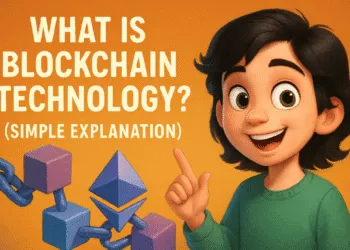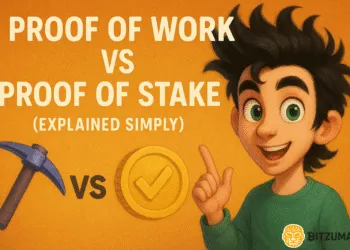Smart contracts are everywhere in crypto — but what are they, really?
Despite the name, they’re not “contracts” in the legal sense, and they’re definitely not “smart” like artificial intelligence. Instead, smart contracts are self-executing programs that live on the blockchain. They run automatically when specific conditions are met — no lawyers, no delays, no middlemen.
You interact with smart contracts every time you Swap tokens on a DEX, Mint an NFT, Stake your crypto or vote in a DAO.
They’re the invisible layer powering most of Web3 — from DeFi to gaming and beyond.
In this guide, we’ll break down:
- What a smart contract actually is
- How it works under the hood
- Where it’s being used today
- What benefits (and risks) it brings to the table
What Is a Smart Contract?
A smart contract is a piece of code stored on a blockchain that runs automatically when certain conditions are met. Once deployed, it can’t be changed — and it doesn’t require anyone to manage or approve it.
Think of it as a digital agreement that enforces itself:
“If X happens, then do Y.”
The most important part? It executes trustlessly. That means you don’t need to rely on a company, a lawyer, or any third party. The code handles everything — transparently and automatically.
📜 Real-World Analogy: Imagine a vending machine. You insert money, press a button, and out comes your snack. No cashier needed. That’s what a smart contract does: it delivers results based on predefined inputs, with no human intervention.
Smart contracts are the backbone of Web3. They allow developers to build apps (called dApps) that run entirely on blockchain — unlocking a new internet based on transparency, ownership, and automation.
How Do Smart Contracts Work?
Smart contracts are written in programming languages designed for blockchain — like Solidity on Ethereum.
Once the code is written, it’s deployed onto the blockchain. From that moment, the contract is immutable — it can’t be edited or deleted. Anyone can interact with it by sending a transaction that meets its predefined conditions.
Let’s say a contract is programmed to release funds when two parties sign. Once both digital signatures are detected, the contract executes itself, sends the funds, and records everything on the blockchain.
There’s no negotiation, no human approval — just automated, trustless execution.
Every time someone uses a smart contract, they pay a gas fee (a small amount of crypto) to cover the cost of running the code on the network. The contract then performs its task instantly and transparently.
⚙️ Pro Tip: Once a smart contract is live, it can’t be changed — not even by the developer. That’s why many projects undergo security audits before deployment.
What Can Smart Contracts Be Used For?
Smart contracts power some of the most innovative applications in the crypto space. If you’ve ever traded on a DEX, bought an NFT, or joined a DAO — you’ve already used one.
Here are just a few real-world examples:
- DeFi (Decentralized Finance):
Smart contracts automate lending, borrowing, and swapping crypto on platforms like Aave, Uniswap, and Curve — no banks needed. - NFTs and Digital Ownership:
When you mint an NFT, a smart contract creates and transfers the digital asset, permanently recording ownership on the blockchain. - DAOs (Decentralized Autonomous Organizations):
These are online communities governed by smart contracts — from voting systems to treasury management. - Gaming and Metaverse:
Smart contracts distribute in-game rewards, verify digital assets, and enable player-owned economies. - Insurance and Real-World Agreements:
For example, a crop insurance policy can automatically trigger a payout if a weather oracle confirms a drought. - Healthcare:
Smart contracts can automate access to medical records — ensuring patients have full control over their data, and sharing is secure and permissioned. - Logistics & Supply Chain:
Contracts can track goods from origin to delivery, automating steps like customs, verification, and payments — improving transparency and reducing fraud.
💡 Pro Tip: Some smart contracts interact with off-chain data via oracles — trusted services that feed real-world info (like prices or weather) into the blockchain.
Benefits vs Limitations of Smart Contracts
Smart contracts bring incredible innovation — but they’re not magic. Like all technologies, they come with both strengths and trade-offs.
| ✅ Benefits | ⚠️ Limitations |
| Automation – Runs without intermediaries | No Flexibility – Code can’t be changed once live |
| Transparency – Open and verifiable code | Bugs = Risk – Vulnerabilities can be exploited |
| Speed – Executes instantly | No Human Judgment – Code follows logic, not fairness |
| Cost Efficiency – Reduces third-party fees | Legal Uncertainty – Often not legally binding |
| Trustlessness – No need to trust people | Complexity – Still hard to use for non-tech users |
🧠 Did You Know? The 2016 DAO hack led to a $50M loss — caused by a bug in a smart contract. It changed Ethereum forever, forcing a hard fork that split the community.
Smart Contract FAQs
Are smart contracts legally binding?
In most countries, smart contracts aren’t yet recognized as legally binding by default. However, they can sometimes support or automate legally valid agreements — depending on local laws and how the contract is written.
Who controls a smart contract?
Once deployed, no one controls it directly — not even the developer. It runs exactly as coded, and its rules can’t be altered unless designed to allow updates (which is rare and risky).
Can a smart contract be changed or cancelled?
Generally, no. Most smart contracts are immutable once deployed. Some can include upgrade mechanisms, but those require careful design and trust in whoever has admin rights.
Are smart contracts only used on Ethereum?
No. While Ethereum is the most well-known smart contract platform, others like Solana, Avalanche, Cardano, BNB Chain, and Polygon also support smart contracts.
What happens if there’s a bug in the smart contract?
If a bug exists in the code, it may be exploited — and there’s often no way to recover lost funds. That’s why auditing and security reviews are essential before deploying contracts on mainnet.
📌 New to security? Learn more in: How to Keep Your Crypto Safe in 2025
Final Thoughts: Smart Contracts Are Reshaping the Web
Smart contracts are more than just code — they’re the building blocks of the new internet. They allow developers to create apps that run automatically, without middlemen, borders, or delays.
From decentralized finance to digital art, from gaming to global supply chains, smart contracts are changing how we interact, trust, and transact online.
But with great power comes great complexity. They require careful design, security audits, and responsible use. Because in the world of blockchain, once the contract is live — there’s no going back.
















